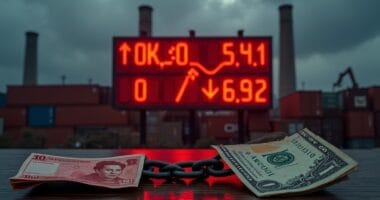Global markets took a nosedive after Trump announced sweeping new tariffs, pushing America’s rate to a staggering 22.5% – the highest since Teddy Roosevelt’s presidency. The Dow plummeted 2.7%, while the S&P 500 and NASDAQ fell 3.3% and 4.4% respectively. Average households face a $3,800 annual hit, with lower-income families losing up to $1,700 yearly. These numbers are just the tip of the economic iceberg.

Global markets plunged into chaos today as former President Trump announced another round of sweeping tariffs, sending the Dow Jones tumbling 2.7% and wiping billions off stock valuations. The S&P 500 took an even harder hit, dropping 3.3%, while the tech-heavy NASDAQ nosedived 4.4%. So much for a calm April.
The latest tariff announcement pushes America’s effective tariff rate to 22.5%, the highest since 1909. Because apparently, we’re nostalgic for Teddy Roosevelt-era trade policies. The immediate impact? A whopping $3,800 annual hit to the average American household‘s wallet. Lower-income families are getting the worst of it, facing losses between $980 and $1,700 per year. Fresh produce shoppers should prepare for sticker shock as prices are expected to see a 2.2% price increase.
The broader economic implications are sobering. GDP growth is expected to drop by 0.9 percentage points – that’s up to $180 billion in economic losses annually. And here’s the kicker: the U.S. economy could permanently shrink by 0.6%. Not exactly the “winning” we were promised. Global supply chains have been severely disrupted, causing production delays worldwide. Investors are rushing to money market funds as a safe haven during this period of market volatility.
These tariffs aren’t cheap for Uncle Sam either. They represent the largest tax hike since 1982, projected to raise federal revenues by $258.4 billion. But there’s a catch – import levels are expected to plummet by 25%, or about $800 billion in trade volume.
The pain isn’t spread evenly across sectors. Clothing prices are set to jump 17%, while automotive and electronics manufacturers scramble to deal with skyrocketing component costs. Small businesses with import-dependent supply chains are feeling particularly squeezed.
Meanwhile, U.S. farmers are bracing for retaliatory tariffs that threaten their international market access. The trade-weighted average U.S. tariff has hit 24%, with tariffs on Chinese imports reaching a staggering 54%.
Global markets from Asia to Europe are reeling from the announcement, as investors flee to safe-haven assets like gold and Treasury bonds. Welcome to 2025’s version of economic diplomacy – where everyone loses.





